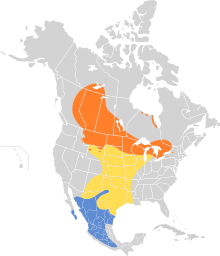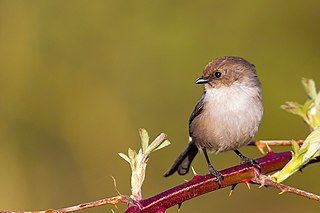
The American bushtit or simply bushtit is a social songbird belonging to the genus Psaltriparus. It is one of the smallest passerines in North America and it is the only species in the family Aegithalidae that is found in United States; the other seven species are found in Eurasia.

The dark-eyed junco is a species of junco, a group of small, grayish New World sparrows. The species is common across much of temperate North America and in summer it ranges far into the Arctic. It is a variable species, much like the related fox sparrow, and its systematics are still not completely resolved.

The American tree sparrow, also known as the winter sparrow, is a medium-sized New World sparrow.
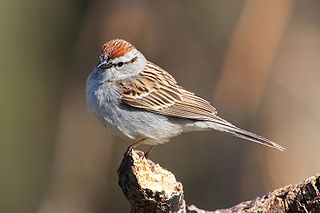
The chipping sparrow is a species of New World sparrow, a passerine bird in the family Passerellidae. It is widespread, fairly tame, and common across most of its North American range.

Brewer's blackbird is a medium-sized New World blackbird. It is named after the ornithologist Thomas Mayo Brewer.

The cliff swallow or American cliff swallow is a member of the passerine bird family Hirundinidae, the swallows and martins. The generic name Petrochelidon is derived from the Ancient Greek petros meaning "rock" and khelidon "swallow", and the specific name pyrrhonota comes from purrhos meaning "flame-coloured" and -notos "-backed".

The field sparrow is a small New World sparrow in the family Passerellidae. It is about 140 mm (6 in) long and weighs about 12.5 g (0.4 oz). The head is grey with a rust-coloured crown, white eye-ring and pink bill. The upper parts are brown streaked with black and buff, the breast is buff, the belly is white and the tail is forked. There are two different colour morphs, one being greyer and the other more rufous.

The pine warbler is a small songbird of the New World warbler family.
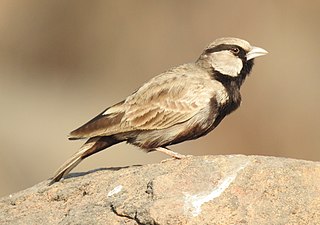
The ashy-crowned sparrow-lark is a small sparrow-sized member of the lark family, belonging to the genus of sparrow larks. It is found in the plains in open land with bare ground, grass and scrub across South Asia. The males are well marked with a contrasting black-and-white face pattern, while females are sandy brown, looking similar to a female sparrow. Males are easily detected during the breeding season by the long descending whistle that accompanies their undulating and dive-bombing flight displays.

Brewer's sparrow is a small, slim species of American sparrow in the family Passerellidae. This bird was named after the ornithologist Thomas Mayo Brewer.

The golden-crowned sparrow is a large New World sparrow found in the western part of North America.

Harris's sparrow is a large sparrow. Their breeding habitat is the north part of central Canada, making it Canada's only endemic breeding bird. In the winter they migrate to the Great Plains states of the United States, from southern South Dakota to central Texas. The common name of this species commemorates the American amateur ornithologist Edward Harris (1799–1863).

The black-chinned sparrow is a small bird in the genus Spizella, in the New World sparrow family Passerellidae. It is found in the southwestern United States and throughout much of Mexico north of the Isthmus of Tehuantepec; most populations in the US migrate south after breeding while those in Mexico are resident. It is a slim, long-tailed bird, primarily gray with a reddish-brown back streaked with black, brown wings and tail, a pink beak, and brownish legs and feet. In the breeding season, the male shows black on his throat, chin, and the front of his face. Females, youngsters and nonbreeding males show little or no black in these areas. An unobtrusive bird, it spends much of its time foraging slowly along the ground, either alone or in small groups, sometimes mixing with other Spizella species. It is an omnivore, feeding primarily on seeds during the winter and insects during the summer. It builds a cup-shaped nest of grasses, rootlets, or plant fibers, into which the female lays 2–5 pale blue eggs. The female does most or all of the egg incubation, but both parents feed the hatched nestlings.

The Cape sparrow, or mossie, is a bird of the sparrow family Passeridae found in southern Africa. A medium-sized sparrow at 14–16 centimetres (5.5–6.3 in), it has distinctive plumage, including large pale head stripes in both sexes. Its plumage is mostly grey, brown, and chestnut, and the male has some bold black and white markings on its head and neck. The species inhabits semi-arid savannah, cultivated areas, and towns, and ranges from the central coast of Angola to eastern South Africa and Eswatini. Three subspecies are distinguished in different parts of its range.
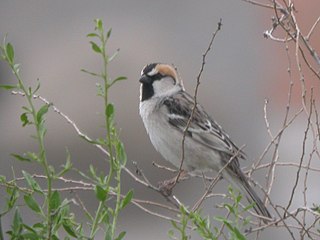
The saxaul sparrow is a passerine bird of the sparrow family Passeridae, found in parts of Central Asia. At 14–16 centimetres (5.5–6.3 in) and 25–32 grams (0.88–1.13 oz), it is among the larger sparrows. Both sexes have plumage ranging from dull grey to sandy brown, and pale brown legs. Females have less boldly coloured plumage and bills, lacking the pattern of black stripes on the male's head. The head markings of both sexes make the saxaul sparrow distinctive, and unlikely to be confused with any other bird. Vocalisations include a comparatively soft and musical chirping call, a song, and a flight call.
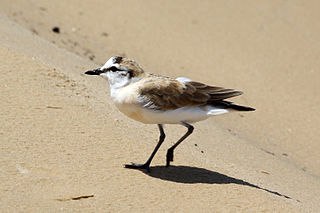
The white-fronted plover or white-fronted sandplover is a small shorebird of the family Charadriidae that inhabits sandy beaches, dunes, mudflats and the shores of rivers and lakes in sub-saharan Africa and Madagascar. It nests in small shallow scrapes in the ground and lays clutches of one to three eggs. The species is monogamous and long-lived, with a life expectancy of approximately 12 years. The vast majority of pairs that mate together stay together during the following years of breeding and retain the same territory. The white-fronted plover has a similar appearance to the Kentish plover, with a white fore crown and dark bands connecting the eyes to the bill.

Worthen's sparrow is a species of American sparrow that is endemic to northeastern Mexico. It was first described by Robert Ridgway in 1884 and named for the American naturalist Charles K. Worthen. This small bird has been listed as endangered by the IUCN since 1994.

The black-crowned sparrow-lark is a species of lark in the family Alaudidae. It is found across northern Africa from Mauritania through the Middle East to north-western India. Its natural habitat is dry savanna.

The scaly-naped amazon, also known as the scaly-naped parrot, mercenary amazon, Tschudi's amazon, mountain parrot, or gray-naped amazon is a species of parrot in the family Psittacidae. It is found along the Andes in the northern part of South America. Its natural habitats are subtropical or tropical moist lowland forest and subtropical or tropical moist montane forest.

The grey-capped social weaver is a sparrow-like liver-colored bird, with a pale grey crown, a dark grey bill, a whitish eye-ring, horn-colored legs, with some black in the wing and a light terminal band in the tail, that builds roofed nests made of straws, breeds in colonies in thorny Acacia trees, and feeds in groups gathering grass seeds and insects. Male and female have near identical plumage. DNA-analysis confirms it is part of the weaver family. It is found in Ethiopia, Kenya, Somalia, South Sudan, Sudan, Tanzania, and Uganda.

